FAILING THE PARTICLE BOARD REVIEW Levels of soot in Houston now exceed the EPA’s longstanding annual limit: “The area of concern is along the Ship Channel, the only place in Texas where levels of the tiny particles surpassed the EPA’s annual limit from 2006 to 2008, according to the most recent data available. The agency uses a three-year average to determine whether an area is in compliance. Monitoring shows air near the Ship Channel is getting cleaner, thanks in part to new rules for idling trucks and the paving of gravel parking lots. But EPA and local officials don’t know whether the improvements will be enough to drop the rolling average below the annual limit of 15 micrograms per cubic liter of air, since that average includes higher 2006 levels.” [Houston Chronicle; previously on Swamplot]
Tag: Air Quality
CEDAR BAYOU AIR UPSETS The Sierra Club and a Texas environmental group have filed suit against Chevron Phillips claiming a bonus supply of air pollutants and toxic chemicals has been escaping from the company’s Cedar Bayou chemical plant just north of I-10 in Baytown: “‘Like many companies in Texas, Chevron Phillips has repeatedly violated its own permit limits by emitting a wide range of harmful pollutants into the air from the Cedar Bayou plant,’ said Luke Metzger, Director of Environment Texas. ‘Because the state of Texas has failed to stop such violations at Cedar Bayou and elsewhere, citizen groups have had to step up and enforce the law themselves.’ The Clean Air Act contains a ‘citizen suit’ provision that allows private citizens affected by violations of the law to bring an enforcement suit in federal court if state and federal regulators do not. . . . Chevron Phillips’s permits contain both hourly and yearly limits on the amounts of pollutants it can emit into the atmosphere. The lawsuit alleges that equipment breakdowns, malfunctions, and other non-routine incidents at the Cedar Bayou complex have resulted in the release of more than a million pounds of pollutants into the surrounding air, frequently in violation of legal limits. A single such ‘upset’ or ’emission event’ can result in the release of tens of thousands of pounds of air pollutants in a matter of hours or even minutes.” [Environment Texas, via Houston Chronicle]
Katy residents living near a pool supply company got breathtaking views of the spectacular black plumes emanating from the RAM Chemical and Supply warehouse at 4949 Greenhouse Rd. during last weekend’s fire.
But the fun wasn’t entirely over: A separate episode yesterday resulted in a shelter-in-place order for a few hours last night — for downwind neighborhoods east of the Windstone Colony subdivision, stretching from Greenhouse Rd. to Barker Cypress. Fire officials warned of toxic clouds billowing out from a supply of hazardous chemicals still housed in the singed remains of the warehouse.
- Breaking News, Ram Chemical Warehouse Fire! [YouTube]
- RAM Chemical Fire, the Day After [iReport]
- Shelter In Place Order Lifted [Click2Houston]
- Warehouse fire prompts shelter-in-place [abc13]
- Cy-Fair warehouse fire prompts air-quality concerns [Houston Chronicle]
Video: Kevin Neugebauer
WHAT ABOUT THE FLARES? “An estimated 1,600 tons of smog-forming nitrogen oxides and volatile organic compounds are released in the Houston region each day. They mix with sunlight to form ozone, a colorless gas that can cause lung damage. Formaldehyde and other radical precursors matter because, without them, the volatile organic compounds emitted by cars, industry, paints and other consumer products would form much less ozone, [the Houston Advanced Research Center’s Jay] Olaguer said. Industrial flares burn off pressurized gases but also can shoot out massive amounts of noxious emissions. The Houston area has about 400 flare stacks, and they are among the largest and least- understood sources of pollution in the region, researchers said. A recent University of North Carolina study found that formaldehyde from flares may increase Houston’s ozone by as much as 30 parts per billion. In tandem with the pollution that blows into the region from elsewhere, that might be enough to keep Houston from meeting the new federal ozone limit of 75 parts per billion, scientists said. The state’s current plan for reducing Houston’s smog doesn’t consider formaldehyde and other precursors. ‘If there is a problem with flares, it upends the entire regulatory strategy,’ said Harvey Jeffries, an atmospheric chemist who conducted the UNC study.” [Houston Chronicle, via Off the Kuff]
CHINESE DRYWALL AND THE SMELL TEST The first government report on Chinese drywall is out . . . sort of: “On Monday, Florida’s health department said preliminary tests show there’s no ‘specific’ health hazard associated with the sulfur-based gases coming from the drywall, but the agency is conducting additional tests. ‘It’s not that we are saying it’s safe,’ Florida toxicologist David Krause told reporters on a conference call on Monday. ‘We are moving forward on a much more detailed in-depth’ study. The test results released by the state health department on Monday did make one, definitive conclusion: Chinese-made drywall contained strontium sulfide, a material that’s known to have the odor of hydrogen sulfide in moist air. The U.S-made drywall did not contain this material. The most common evidence of Chinese drywall problems is the corrosion of air conditional equipment, which is turning black and failing repeatedly. Homeowners have also complained about respiratory problems they believe are connected to the drywall.” [Developments]
WHERE’S A STINKIN’ FEMA TRAILER WHEN YOU NEED ONE? Trailer sculptor Paul Villinski, on the difficulty of procuring the raw material for his Emergency Response Studio, now on display at the Rice Art Gallery: “I thought, OK I’m going to go get a FEMA trailer, because they’re selling them online through the government – you know, the GAO Web site – at that very moment, it seemed, FEMA basically stopped releasing the trailers into the marketplace. And not only did they do that, they bought back all the ones that they had already sold. . . . And the back story with that is basically that the plaintiffs in this class-action suit need a couple of FEMA trailers so they can really study the indoor air quality and FEMA and the manufacturers do not want them to have them. So they’ve been ordered by the judge in the case to release the trailers, and they haven’t done it yet. So that made it impossible for me to actually get a FEMA trailer, which is why I wound up finding a 30-foot Gulfstream Cavalier, but it was built a couple of years before the FEMA trailers were.” [Arts in Houston; previously in Swamplot]
SOOT’S US Some public-health and environmental groups are complaining that Houston isn’t getting enough respect for the particularly fine quality of the air here, and are asking the EPA to give this city the recognition it deserves: “Houston’s concentrations of soot — a piercing mix of airborne matter from diesel exhaust, industrial flares and road grit, among other sources — exceeded the EPA’s yearly standards from 2005 to 2007, according to the most recent federal data available. . . . ‘Residents of Houston are breathing unhealthy levels of soot pollution,’ [the NRDC’s John] Walke said in an interview this week. . . . Soot has been a special concern near the Houston Ship Channel, which is home to heavy industry and a busy port. It’s the only place in Texas where the particulate-matter levels exceed the annual standard.” [Houston Chronicle]
HOUSTON LOOKS GOOD IN SOOT Publicizing ozone problems is a smart strategy for Houston, because the city gets to be compared to L.A.! But that’ll get all mucked up if we have to start paying attention to particle pollution too. Fortunately, that isn’t happening quite yet: “In 2006, the EPA lowered the limit on how much soot Americans can be exposed to in 24 hours from 65 micrograms per cubic meter of air to 35. But the agency left unchanged the annual limit — an average of 15 micrograms per cubic meter per day over the course of a year. The agency’s science advisers recommended an annual standard as low as 13 micrograms to protect public health. Since then, Houston’s year-round levels of particles have worsened, averaging about 15 micrograms per day for each year. But the region remains in compliance because the EPA doesn’t plan to look at the cities violating the annual standard until it’s lowered again.” [Houston Chronicle]
BLOWING THIS WAY FROM TEXAS CITY “[Sunday] night for about two hours, BP’s refinery released an estimated 2,725.59 pounds of sulfur dioxide when the pressure spiked during a planned shutdown — so if you were cruising through Texas City and noticed a suffocating smell that may have been it. Meanwhile, starting [Monday], and continuing for the next week, BP has three more emissions events scheduled that are related to maintenance and the aforementioned planned shutdown at the refinery. Through the magic of the Internet, you can determine the substances involved in the releases, which include benzene.” [Hair Balls]
[youtube:http://www.youtube.com/watch?v=l6btY7WqNBM 400 330]
Frustrated that his occasional reports on area petrochemical-plant emissions events haven’t received more attention, Banjo Jones of the Brazosport News (aka former Chronicle reporter Steve Olafson) resorts to video. His first feature: the odorous results of a power outage this past Sunday at the Chevron Phillips chemical plant in Old Ocean. That’s in Brazoria County, about an hour’s drive southwest of Houston.
- Caught on videotape !! [Brazosport News]
- Old Ocean, Tex., the hellhole they call home [YouTube]
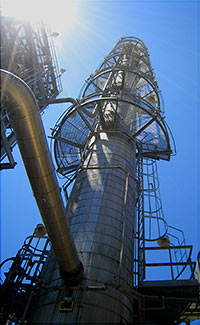 Finding it hard to stay healthy in Houston? Do you find yourself wheezing and coughing . . . maybe because you’re uh, so out of shape? Blogger and chemical-plant worker Baytown Bert has come up with a solution: Industrial Trekking.
Finding it hard to stay healthy in Houston? Do you find yourself wheezing and coughing . . . maybe because you’re uh, so out of shape? Blogger and chemical-plant worker Baytown Bert has come up with a solution: Industrial Trekking.
Industrial Trekking (IndyTrek) is a planned path consisting of climbing/walking obstacles or evolutions inside a refinery, chemical plant, factory, water treatment plant or even a large office building whereby a person can use stairs and ladders to promote fitness. An IndyTrek typically consists of 8-10 evolutions, usually requiring an hour to complete.
What a great way to get out, lose some weight, and get some fresh air, too! But how can anyone find the time?
I do it on the clock, as I can do it while strolling through the Chemical Plant I work in, but it can be done anywhere stairs are and in time-frame sections, throughout the day until all the evolutions are completed. It can be incorporated into your daily schedule (while on the clock or on break).
After the jump: A Baytown Bert photo shows an IndyTrekker in action!
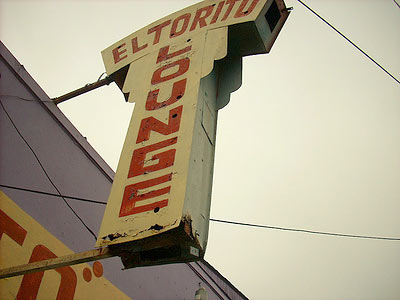
Houston’s lone professional tourists, John Nova Lomax and David Beebe, stop off at the Brady’s Island in the Ship Channel midway into their latest day-long stroll . . . through this city’s southeastern stretches:
The air is foul here, and the eastern view is little more than a forest of tall crackers and satanic fume-belching smokestacks, sending clouds of roasted-cabbage-smelling incense skyward to Mammon, all bisected by the amazingly tall East Loop Ship Channel Bridge, its pillars standing in the toxic bilge where Brays Bayou dumps its effluent into the great pot of greenish-brown petro-gumbo.
While Brady’s Landing today seems to survive as a function room – a sort of Rainbow Lodge for the Ship Channel, with manicured grounds that reminded Beebe of Astroworld — decades ago, people came here to eat and to take in the view. This was progress to them, this horrifically awesome vista showed how we beat the Nazis and Japanese and how we were gonna stave off them godless Commies. As for me, it made me think of Beebe’s maxim: “Chicken and gasoline don’t mix.â€
More from the duo’s march through “Deep Harrisburg”: Flag-waving Gulf Freeway auto dealerships, an early-morning ice house near the Almeda Mall, a razorwire-fenced artist compound in Garden Villas, Harold Farb’s last stand, colorful Broadway muffler joints, the hidden gardens of Thai Xuan, and — yes, gas-station chicken.
“There is nothing else like the Southeast side,” Lomax adds in a comment:
I see it as the true heart of Houston. Without the port and the refineries we are nothing. The prosperous West Side could be Anywhere, USA, but the Southeast Side could only be here.
- Sole of Houston: Deep Harrisburg: Lomax and Beebe Take on the East Side Again [Houstoned]
- Brady’s Landing
- Previously in Swamplot: Long Point, Long Walk, Long Story, Telephone Road Walking Tour: Not How They Sang It Was, Shade, Subs, Plexes and Suds: A Bissonnet Story, Lonely East Side Walking Tour, Walking on Bellaire
Photo of El Torito Lounge on Harrisburg: John Nova Lomax and David Beebe
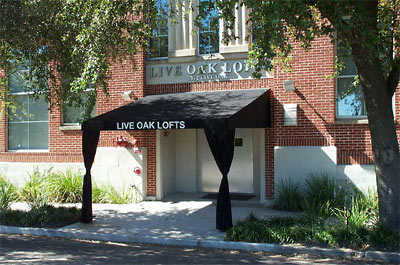
Residents of the Live Oak Lofts, you have been warned! Whoever among you has been smoking weed and stinking up the whole joint, you must cease immediately — the Live Oak Lofts Homeowners Association is on the case!
Don’t want to get all up in your business and all, but now that this has happened, the Association will not fail to contact the proper authorities if anything incriminating is further sniffed — or if you are caught doing anything illegal whatsoever!
After the jump, the scathing marijuana memo distributed to all residents of the Live Oak Lofts!
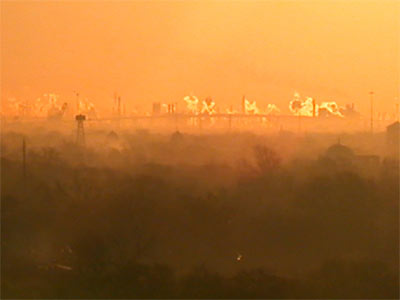
That beautiful flare glowing from atop ExxonMobil Chemical’s Olefins plant in Baytown last Thursday night wasn’t just a pretty New Year’s display for the city. It came with a couple of bonuses: two “not specifically authorized” releases, including 6,857 pounds of benzene, plus a bunch of other fun toxins.
Not to be outdone, the nearby ExxonMobil oil refinery decided to celebrate the new year in its own special way, releasing a bouquet of smelly agents including 3,010 lbs. of neurotoxicant carbonyl sulfide into our lovely Gulf air.
Now when Houston visitors ask you why the east side of the city has an odor reminiscent of cooked cabbage, you’ll be able to explain why.
Meanwhile, two environmental organizations are interrupting the normal course of business over in Deer Park with a pesky lawsuit:
“On average of more than once a week for at least the past five years, Shell has reported that it violated its own permit limits by spewing a wide range of harmful pollutants into the air around the Deer Park plant,” said Luke Metzger, executive director of Environment Texas.
- ExxonMobil emits thousands of lbs. of benzene and other nastiness to mark new year in East Harris County, TX [Brazosport News]
- Air Emission Event Report for Tracking Number 101998 [TNRCC]
- Air Emission Event Report for Tracking Number 102061 [TNRCC]
- Environmental groups file suit against Shell Oil [Houston Business Journal]
- Groups sue over refinery pollution [Galveston County Daily News]
Photo of Baytown sunrise: Bill Jacobus
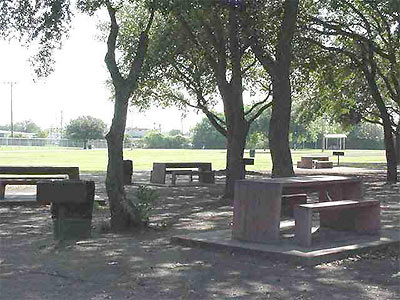
Looking for a home in an in-town location, but don’t want to miss that exhilarating feeling you get from East Side neighborhoods near the Ship Channel?
Why not start your search near Bayland Park, at the corner of Bissonnet and Hillcroft, just west of Bellaire? It’s outside the Loop, far to the west of Houston’s industrial areas, close to some of some of the city’s most dynamic neighborhoods . . . and recently was rated one of the most consistently smoggy places in Houston.
That’s right: Smog is worse on the West Side.
The data may surprise many Houstonians who associate smog with the chemical refining and industrial byproducts that foul the air in East Harris County.
In fact, the highest ozone readings in the city are routinely captured by monitors located on Houston’s densely populated southwest side. Recent data shows Bayland Park, just west of Bellaire, to be one of Houston’s smoggiest neighborhoods. According to the Texas Commission on Environmental Quality, the Bayland Park monitor, located in the 6400 block of Bissonnet Street, recorded 45 days in the last three years when ozone levels violated public health standards.
During that period, the monitor registered ozone concentrations as high as or greater than those recorded by monitors in the Ship Channel region.
Howzat happen?
University of Texas chemical engineer David Allen analyzed data collected by the Bayland Park monitor in 2006. He and others determined that climate patterns explained the high ozone concentrations on Houston’s west side. Based on computerized modeling of weather patterns, Allen said nearly every incident of excessive ozone levels in Bayland Park that year happened on days characterized by the same weather pattern: hot and sunny, with still air in the morning and light winds from the east blowing in the afternoon.
“The east winds pick up Ship Channel air and carry it all the way into west Houston where it settles over neighborhoods,†Allen said.
That’s the smell of money.
- Dubious honor: Bayland leads in bad air [Bellaire Examiner]
Photo: Harris County Precinct 3

